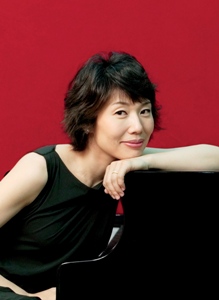Boston Philharmonic delivers boldly dramatic Sibelius

HaeSun Paik performed Brahms’ Piano Concerto No. 2 with Benjamin Zander and the Boston Philharmonic Thursday night.
Benjamin Zander has an eye for the fine details and enveloping drama of some of the grandest works in the symphonic repertoire. Just last season he led the Boston Philharmonic in vivid performances of Bruckner’s Seventh Symphony and Mahler’s Ninth. And he opened the orchestra’s current season in October with an unforgettable rendering of Rachmaninoff’s Second Symphony.
Thursday night at Sanders Theatre, Zander and the Boston Philharmonic turned their attention to the music of Jean Sibelius, offering colorful performances of two of the composer’s most beloved scores, Finlandia and The Swan of Tuonela, as well as a powerful reading of the taut and concentrated Symphony No. 7.
Cast in a single movement, the Seventh Symphony, Sibelius’ final work in the genre, is one of the composer’s greatest achievements.
The work’s experimental structure can be difficult to grasp even after repeated hearings, for, as Zander himself noted in his remarks about the piece, the whole symphony is a transition. The themes, once formed, are penetrating in their effect, but they appear and disappear like breezes.
The symphony is also seamless in form, and the Boston Philharmonic maneuvered the work with clear direction from Zander. The fast sections, which moved with dance-like energy in Thursday’s performance, unfolded effortlessly from the more solemn statements. The orchestra’s brass added brief hints of warmth, but the music turned cold again from the dark chromatic lines of the woodwinds and the coolly distant tone of the strings. With sensitive playing from the orchestra, the symphony unfolded like a landscape as viewed from a great height. Zander, leading with deliberate gestures, delivered a bold performance of a work that deserves many repeated hearings.
Finlandia, which opened the concert, is Sibelius’ most nationalistic work. Composed as a covert protest against the Russian Empire’s censorship of the Finnish press, the piece helped crystallize the composer’s reputation as Finland’s national hero.
The Boston Philharmonic gave the work a rousing performance. The brass and timpani played the opening chords with earth-shaking power. The ensuing march was given appropriate pomp and toe-tapping energy. Strings and winds played the hymn that is central to the work with smooth but stately grace.
Finlandia complemented what followed, Sibelius’ The Swan of Tuonela. Based on a story from Finnish mythology, this symphonic poem is a work of haunting melody and silky orchestral textures.
Zander led a reading of utmost sensitivity. The Boston Philharmonic strings opened with strands of glassy harmony, the music like a great dark lake upon which English hornist Peggy Pearson floated lines of palpable sadness.
After intermission, Zander led the Boston Philharmonic in Brahms’ Piano Concerto No. 2, which featured Korean pianist HaeSun Paik as soloist.
At the keyboard, Paik commands a powerful technique and a pearly tone that resonates deeply in every dynamic range. Those characteristics suited her interpretation of the concerto, which mined the poetic depths from this familiar war horse.
It wasn’t a perfect performance. String attacks were sometimes unfocused, and Paik’s sparkling runs were marred by a few clinkers. But those mistakes didn’t get in the way of an affecting reading that beamed from clear communication between conductor, orchestra, and soloist.
Paik’s passages in the first movement were dynamic. She laid on the thunder for the cascading phrases while easing off for others, the music in both cases rippling like a country brook. Zander led with a deliberate tempo that was never stiff, the opening horn call and Paik’s answer flowing together as if a single statement. Paik’s most dazzling playing came in the finale, where she gave the trickling phrases a fine, dexterous touch, her sound never losing its crystalline quality.
Zander and Paik emphasized the marked appassionato of the second movement Allegro, with soloist and orchestra taking a smooth approach to the syncopations that characterize the opening. It was an effective interpretation, though, at times, one missed the earthy power so often experienced in the movement.
The Andante offered another break from traditional readings of the concerto as Zander pushed the tempo, the lines, as a result, moving gracefully in the strings. The music central to the movement unfolded in sheets of warm, enveloping sound, with Paik gently sprinkling her figures overhead to create soft, spacious phrases.
The audience responded to Paik’s performance with warm applause, though she wasn’t the only hero of the concerto. Cellist Rafael Popper-Keizer was duly acknowledged for his role in the third movement, where he lofted his solo line with silvery tone and brilliant focus.
The program will be repeated 8 p.m. Saturday at Jordan Hall and 3 p.m. Sunday at Sanders Theatre. bostonphil.org.
Posted in Performances